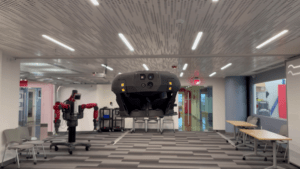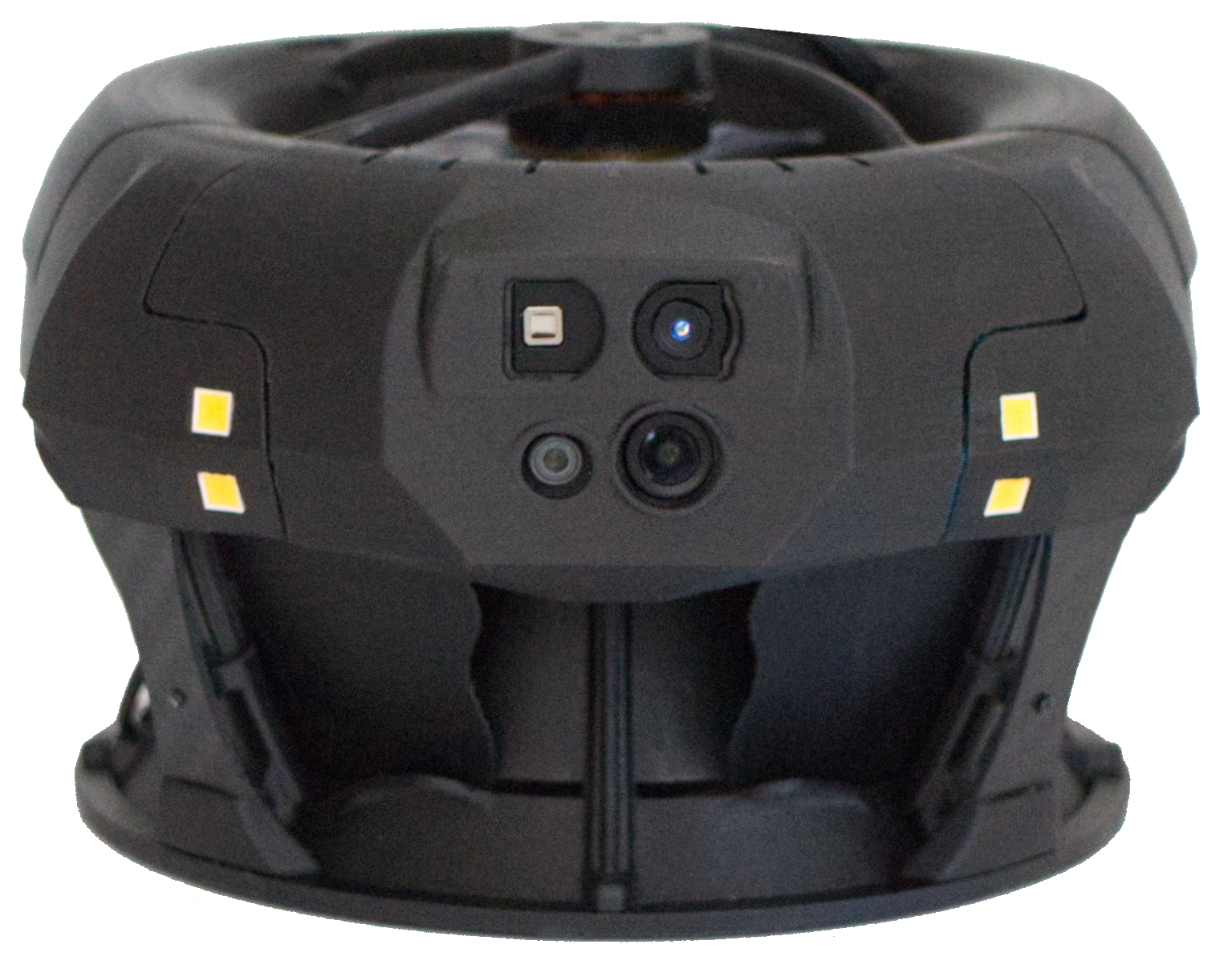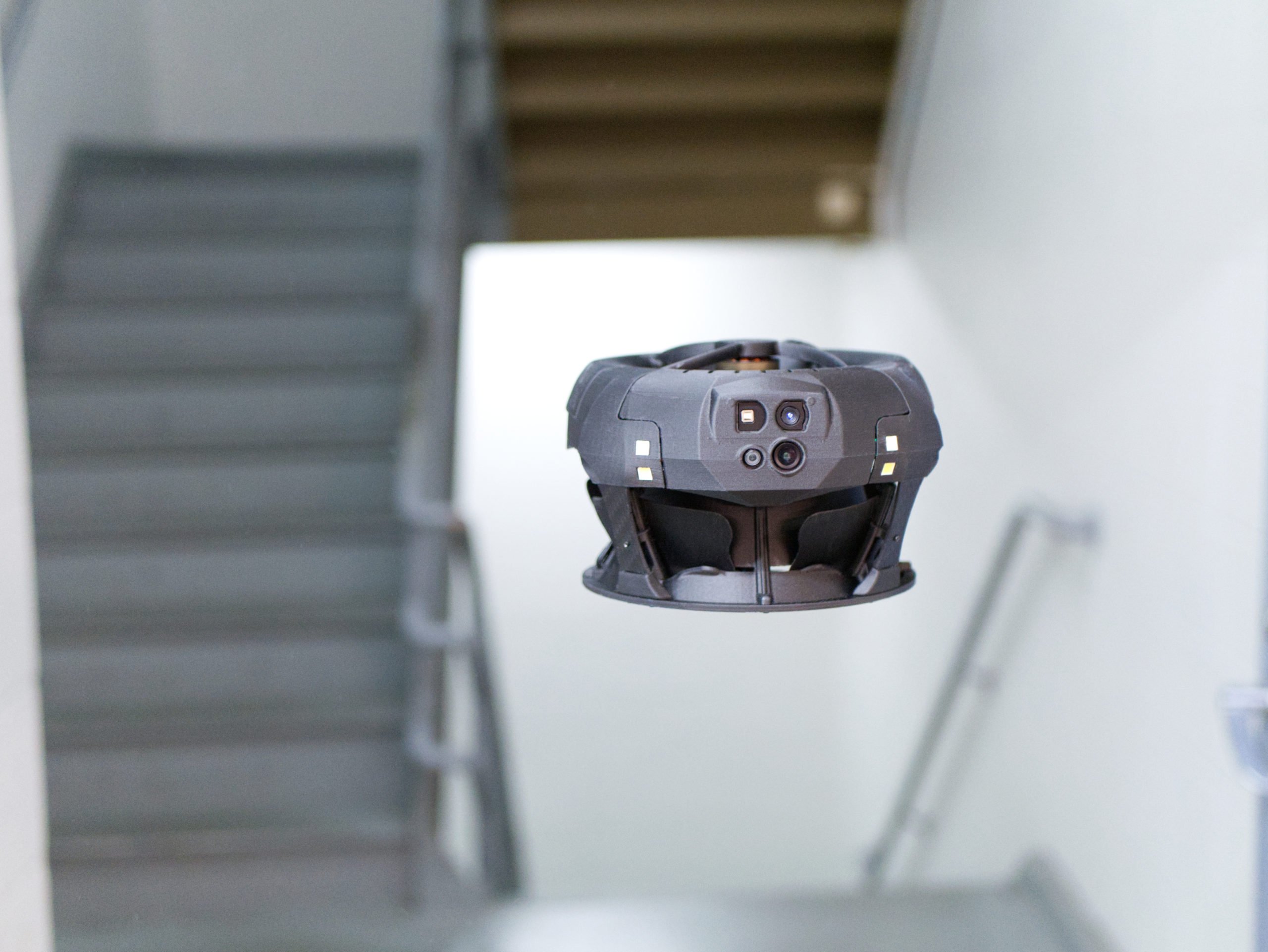 Small drone without exposed rotor blades suited for use in tight, hazardous spaces
Small drone without exposed rotor blades suited for use in tight, hazardous spaces
By Jim Magill
Looking like a micro-sized version of the Death Star, the Dronut X1, which Boston-based start-up Cleo Robotics released for commercial use earlier this month, is the first professional-grade bi-rotor ducted-fan drone – a drone without exposed rotor blades – built to conduct inspections in close-quartered and hazardous environments.
Its unique design, featuring hidden propellers and rounded form, means the Dronut is collision-tolerant and can be operated near sensitive equipment, Cleo Robotics’ CEO and co-founder Omar Eleryan said in an interview.
“The Dronut X1 is the first drone in the world that’s based on ducted-fan drone technology that performs as well as a quadcopter drone in terms of maneuverability, but exceeds the performance of quadcopters in terms of flight time and the ability to bump into things, especially in its current form factor,” Eleryan said.
Built from strong but light carbon-fiber composite materials, weighing just under one pound and measuring 6.5 inches across, the Dronut X1 can also be launched by hand and safely come into direct contact with people without risk of bodily harm.

The drone features LiDAR-powered obstacle detection, and a sensor suite built for image and data collection with HD photo/video and 3D point-cloud output. With its Dronut X1 pilot assist – powered by Qualcomm Snapdragon – the flying robot does not need to be operated by a highly trained drone pilot. The software makes flying the craft easier and safer, allowing the operator to focus on collecting the needed data instead of manually managing the drone’s flight path.
“It also has several gyroscopes on board and LED lights for low-light environments,” Eleryan said.
Cleo Robotics was founded in 2017 to specialize in “unconventional drones that fly in places where typical drones can’t fly and they are really meant to go into places that are too hazardous or dangerous for people to go into,” he said.
Eleryan, who had previously worked in the oil and gas industry, said his team started the company to find a solution for conducting inspections in confined spaces that could prove to be hazardous for humans.
“I personally had been in situations where I and several of my colleagues had to go into some really dangerous, dirty and hazardous environments, tanks and pressure vessels,” he said. “We thought, instead of sending people into those environments, why not send in some kind of robot equipped with the cameras and sensors that were necessary?
Finding that existing robots and drones were not up to the task, the Cleo robotics team set about designing their own drone, one that was small and resilient enough to operate in cramped environments, and one without exposed and whirring rotor blades that could damage or destroy sensitive lines and gauges.
“Drones, quadcopter drones specifically, are too big, they have exposed propellers, so they’re not the ideal tool. Ground robots can’t climb scaffolding or travel vertically, so they don’t work either,” he said.

Although research into the development of ducted-fan drones had been going on for several years, none had been brought to market. The ducted fan drones then under development had some advantages, such as greater efficiency and smaller size, when compared with conventional multi-rotor drones. But those ducted-fan models were extremely difficult to control and maneuver.
“We set out to create a solution that allows ducted-fan drones that were as controllable and maneuverable as quadcopter drones,” Eleryan said. In designing the Dronut X1, Cleo introduced a patented thrust-vectoring technology, which makes the ducted-fan design stable in flight. The UAV also uses a camera than runs a computer-vision algorithm for localization and positioning.
Offering a drone system that sells for just under $10,000, Cleo Robotics already has attracted several major customers in the industrial and commercial space, including FM Global, a property insurance company, and major oil and gas company Chevron, as well as some customers in the construction industry and in the government sector.
One of its early clients is the U.S Army, which has adopted the drones as an intelligence, surveillance and reconnaissance (ISR) solution for use in GPS-denied environments, Eleryan said.
“They use it to get eyes on environments before actually going in. They clear buildings and caves, and other environments of that nature,” he said.
Manufactured in Boston, using American-sourced parts, the Dronut X1 is compliant with the provisions of the National Defense Authorization Act, which makes it available for use by the Department of Defense and other federal agencies.
“There’s a huge opportunity for drones that can operate indoors and in confined spaces. The drone industry is a very big industry, but drones so far have been limited to operating in open fields far away from people,” Eleryan said. “I think there’s a lot of opportunities to bring that technology closer to people, whether that’s on the factory floor or inside warehouses.”
Read more in-depth articles from Jim Magill on personal eVTOL vehicles, 3D mapping the Italian town of Positano, and the small U.S.-based company taking on the global market in crop-spraying drones.
 Jim Magill is a Houston-based writer with almost a quarter-century of experience covering technical and economic developments in the oil and gas industry. After retiring in December 2019 as a senior editor with S&P Global Platts, Jim began writing about emerging technologies, such as artificial intelligence, robots and drones, and the ways in which they’re contributing to our society. In addition to DroneLife, Jim is a contributor to Forbes.com and his work has appeared in the Houston Chronicle, U.S. News & World Report, and Unmanned Systems, a publication of the Association for Unmanned Vehicle Systems International.
Jim Magill is a Houston-based writer with almost a quarter-century of experience covering technical and economic developments in the oil and gas industry. After retiring in December 2019 as a senior editor with S&P Global Platts, Jim began writing about emerging technologies, such as artificial intelligence, robots and drones, and the ways in which they’re contributing to our society. In addition to DroneLife, Jim is a contributor to Forbes.com and his work has appeared in the Houston Chronicle, U.S. News & World Report, and Unmanned Systems, a publication of the Association for Unmanned Vehicle Systems International.
Miriam McNabb is the Editor-in-Chief of DRONELIFE and CEO of JobForDrones, a professional drone services marketplace, and a fascinated observer of the emerging drone industry and the regulatory environment for drones. Miriam has penned over 3,000 articles focused on the commercial drone space and is an international speaker and recognized figure in the industry. Miriam has a degree from the University of Chicago and over 20 years of experience in high tech sales and marketing for new technologies.
For drone industry consulting or writing, Email Miriam.
TWITTER:@spaldingbarker
Subscribe to DroneLife here.
https://dronelife.com/2021/11/30/drone-without-exposed-rotor-blades-the-dronut-is-perfect-for-small-hazardous-spaces/
 Unmanned Aerial Vehicle The latest drone news
Unmanned Aerial Vehicle The latest drone news



